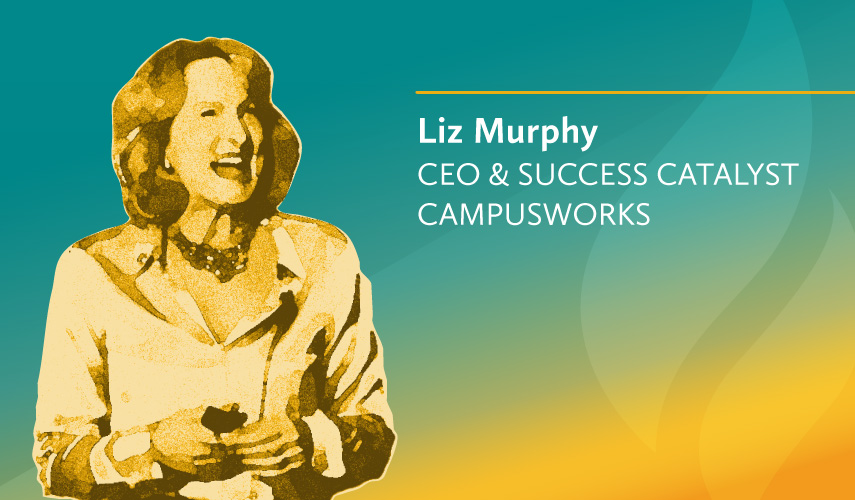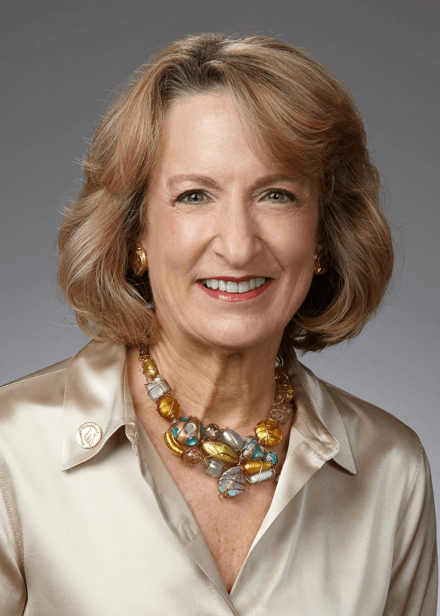
Courageous Leadership
Leading Beyond Fear
By Liz Murphy, CEO, CampusWorks
Over the course of my 40-year career in higher education, I’ve witnessed profound changes that have reshaped the academy. I recall a time when the very concept of ERP systems was new—when the processes that ran the administrative backend of institutions weren’t automated or integrated. We relied on “sneakernet” and manila envelopes to share information across departments. Enrollment pressures were minimal, and the onus was on students, rather than institutions, to secure funding and navigate their education.
As I reflect on how things have changed, one truth endures: It has always been the courageous leaders who have driven progress in higher education. These leaders have been willing to challenge the status quo, push boundaries, and make bold decisions that, while uncomfortable, were essential for advancing not just their institutions but society at large. As we navigate the complexities and pressures confronting higher education today, it is this kind of courageous leadership that is not only necessary but critical for our survival and success.

Liz Murphy
Chief Executive Officer & Chairman of the Board
Educated by Jesuits at the University of Scranton, Liz learned that no question is insignificant and that always asking “why” would expand not only her knowledge, but the impact she could have on the world. Her passion for higher education is inspired by the uplifting effect it has had on her life — like so many of us — and by the desire to empower everyone to reach their full potential by having the tools, environment, and support they need to do so. The impact she has made spans three decades and her work has touched countless lives.
Liz joined CampusWorks as CEO in 2011, after 22 years at Datatel (now Ellucian), and immediately saw and embraced a larger vision for how the company could support colleges and universities in their mission to change lives through education. Under Liz’s leadership, the CampusWorks team has grown from a few dozen employees to several hundred innovative thinkers and leaders able to solve the toughest of challenges. Liz leads by example. Calm, determined, and always thoughtfully intentional, Liz builds meaningful and lasting relationships that spell client and organizational achievement. Perhaps the greatest testament to her leadership are her team members who work hard to serve our clients and are inspired to make the impossible possible — and to make everyone around them happier and more fulfilled.
Change and Progress
When I began my career, postsecondary education was not democratized. Community colleges were often dismissed as institutions for those deemed not smart or wealthy enough to attend a “real” college. Workforce needs were met by those who did not pursue higher education, and the role of four-year institutions was clear-cut and unchallenged.
However, over the decades, I’ve seen a massive shift. Community colleges have become incubators of innovation. And four-year institutions are now competing in workforce development—a space they once largely ignored. Student loans and the accessibility of higher education have also undergone significant transformation. Where once the burden of financing education was solely on students, today, institutions are more accountable and have a greater role in enabling access to education.
These shifts have created new stressors for higher education, particularly as we face a decreasing population of traditional college-age students. The pressure on institutions to attract and retain students has never been greater. This new reality demands a level of courage that goes beyond simply managing change—it requires leaders to actively shape the future.
Courageous Leadership in Action
I’ve been inspired by leaders who exemplify what it means to lead courageously. One such leader is Dr. Paul LeBlanc, former president of Southern New Hampshire University (SNHU). I vividly remember when Paul shared his vision of transforming SNHU into a non-regional institution that could reach students nationwide, offering degrees without the need to step foot on a physical campus. At the time, this idea was revolutionary—no one else was thinking on such a scale.
Paul’s courage wasn’t just in his vision, but in his relentless pursuit of that vision. He convinced his organization of the societal impact this mission could have, making the seemingly impossible feasible. His leadership has had a profound impact, not just on SNHU, but on the broader landscape of higher education, proving that with courage and conviction, even the most ambitious goals can be achieved.
Another example is Dr. Karen Stout, who, a few years ago, boldly prioritized the diversity, equity, and inclusion (DEI) agenda at Achieving the Dream. This was a courageous move given the political climate. Karen’s courage was rooted in her guiding principles and her belief in the necessity of advancing society through inclusivity. Both Paul and Karen were driven by a strong sense of responsibility and mission, which fueled their courage to move forward despite the challenges.
A Call for Courage
In today’s challenging political and economic environment, the need for courageous leadership is greater than ever. Leaders are bombarded with pressures and opinions from all sides, making it easy to become paralyzed by indecision or fear. Yet, staying grounded in one’s beliefs and pushing forward, even when the path is uncertain, is crucial.
Courageous leaders understand that bold strategic plans often come with discomfort. They are willing to face that discomfort, knowing that failure to act can lead to the demise of their institution. This is not just about maintaining the status quo; it’s about recognizing the new realities of higher education and adapting to them. The demographic cliff is real, and so is the demand to remake the underlying business model that supports postsecondary education. Institutions that do not acknowledge these new realities and respond with courage may not survive.
The Cost of Inaction
We are already witnessing the consequences of fear, indecision, and inaction. Institutions are struggling to survive in the current economic climate. Failure to address the challenges head-on—whether it’s adapting to a shrinking pool of traditional students, embracing new technologies, or rethinking the role of higher education in workforce development—can have dire consequences.
Leaders who shy away from difficult decisions, who fail to collaborate or communicate effectively, risk not just their own positions but the future of their institutions. Leaders must demonstrate a willingness to collaborate and solve problems, even on a small scale, and to clearly articulate the reasons behind their decisions. This kind of decisiveness and transparency will drive institutions forward.
Advice for Aspiring Courageous Leaders
For those new to leadership, this is a moment of great opportunity. You have the chance to ask questions, listen, and connect the dots between your institution’s objectives and the challenges it faces. Courageous leadership is about staying centered, true to your guiding principles, and always being ready to adapt to change.
Engagement is key—both with your support system and with those you lead. Listen attentively, solve problems creatively, and remain open to new ideas. And remember, even after you’ve found a solution to a problem, the work is not done. Higher education is constantly evolving, and leaders must be prepared to evolve with it.
Hope for the Future
As I look to the future, I am hopeful. I believe that our society is better when more people are educated, when there is a zeal for learning that extends beyond the classroom. Education not only enriches the human spirit but also equips individuals with the tools they need to solve problems, engage in meaningful dialogue, and make informed decisions.
In the pages that follow, you will hear stories from courageous leaders who have faced and overcome formidable challenges with unshakable resolve. My hope is that their stories will inspire you and galvanize leaders to embrace courage and rise to the challenges before us. Together, we can ensure that higher education remains accessible, relevant, and transformative for all who seek it—because our future depends on it.

